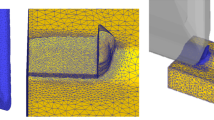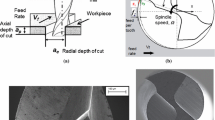Abstract
Surface roughness and residual stress are related to the fatigue life of finished parts. However, experimental investigations lack a deep discussion about the cutting mechanism. Orthogonal cutting simulation for milling or two-dimensional finite element model is the simplification of the actual milling process, which makes it difficult to reflect the milling characteristic in the simulation. In the present study, a three-dimensional coupled thermo-mechanical simulation model was established to analyze the surface roughness and residual stress in milling 5083 aluminum alloy. Explicit dynamic analysis was used as the solution algorithm for the milling process. Implicit analysis was adopted to simulate the process of unloading and cooling. Mesh sensitivity analysis was conducted to identify the mesh size of the workpiece. Node displacement and stress information were output to calculate the surface roughness and residual stress. The effects of cutting parameters on surface roughness and residual stress were discussed by the simulation model. Moreover, milling experiments were conducted to validate the simulation results. It is observed that the surface roughness of the simulation and experiment shows the same trend with the increase of feed per tooth and depth of the cut, which verifies the simulation model. Moreover, the superficial residual stress of the machined surface is the result of the coupled thermo-mechanical with the compressed effect of the tool, the tensile effect of the tool, and thermal load. The superficial residual stress of the machined surface presents compressive stress at a different feed per tooth and spindle speeds. Current findings provide insights for understanding the formation mechanism of the surface topography and residual stress in milling aluminum alloy.














Similar content being viewed by others

Data Availability
The data that support the findings of this study are available from the corresponding author upon reasonable request.
Code availability
Not applicable.
References
Ding Y, Gao K, Huang H, Wen S, Wu X, Nie Z, Guo S, Shao R, Huang C, Zhou D (2019) Nucleation and evolution of β phase and corresponding intergranular corrosion transition at 100–230 °C in 5083 alloy containing Er and Zr. Mater Des 174. https://doi.org/10.1016/j.matdes.2019.107778
Skiba J, Kossakowska J, Kulczyk M, Pachla W, Przybysz S, Smalc-Koziorowska J, Przybysz M (2020) The impact of severe plastic deformations obtained by hydrostatic extrusion on the machinability of ultrafine-grained AA5083 alloy. J Manuf Process 58:1232–1240. https://doi.org/10.1016/j.jmapro.2020.09.023
Esteves L, Witharamage CS, Christudasjustus J, Walunj G, O’Brien SP, Ryu S, Borkar T, Akans RE, Gupta RK (2021) Corrosion behavior of AA5083 produced by high-energy ball milling. J Alloys Compd 857. https://doi.org/10.1016/j.jallcom.2020.158268
Zhang Y, Bai Q, Zhang F, Wang P (2022) Calculation and analysis of quasi-dynamic cutting force and specific cutting energy in micro-milling Ti6Al4V. Int J Adv Manuf Technol. https://doi.org/10.1007/s00170-022-09086-3
Wang J, Yan Y, Li Z, Geng Y (2021) Towards understanding the machining mechanism of the atomic force microscopy tip-based nanomilling process. Int J Mach Tools Manuf 162. https://doi.org/10.1016/j.ijmachtools.2021.103701
Jamil M, He N, Huang X, Zhao W, Khan AM, Iqbal A (2022) Thermophysical, tribological, and machinability characteristics of newly developed sustainable hybrid lubri-coolants for milling Ti-6Al-4V. J Manuf Process 73:572–594. https://doi.org/10.1016/j.jmapro.2021.10.051
Zhang M, Zhang D, Geng D, Shao Z, Liu Y, Jiang X (2020) Effects of tool vibration on surface integrity in rotary ultrasonic elliptical end milling of Ti–6Al–4V. J Alloys Compd 821. https://doi.org/10.1016/j.jallcom.2019.153266
Karkalos NE, Karmiris-Obratański P, Kurpiel S, Zagórski K, Markopoulos AP (2021) Investigation on the surface quality obtained during trochoidal milling of 6082 aluminum alloy. Machines 9(4). https://doi.org/10.3390/machines9040075
Patru EN, Craciunoiu N, Panduru D, Bica M (2018) Study on cutting temperature and surface roughness during the milling process of aluminium alloys. IOP Conf Ser Earth Environ Sci 172. https://doi.org/10.1088/1755-1315/172/1/012018
Xiong Y, Wang W, Shi Y, Jiang R, Shan C, Liu X, Lin K (2021) Investigation on surface roughness, residual stress and fatigue property of milling in-situ TiB2/7050Al metal matrix composites. Chin J Aeronaut 34(4):451–464. https://doi.org/10.1016/j.cja.2020.08.046
Feng Y, Pan ZP, Lu XH, Liang SY (2018) Analytical and numerical predictions of machining-induced residual stress in milling of Inconel 718 considering dynamic recrystallization. In International Manufacturing Science and Engineering Conference. (51388): V004T03A023. https://doi.org/10.1115/MSEC2018-6386
Feng Y, Hsu F-C, Lu Y-T, Lin Y-F, Lin C-T, Lin C-F, Lu Y-C, Liang SY (2019) Residual stress prediction in ultrasonic vibration–assisted milling. Int J Adv Manuf Technol 104(5–8):2579–2592. https://doi.org/10.1007/s00170-019-04109-y
Feng Y, Hung T-P, Lu Y-T, Lin Y-F, Hsu F-C, Lin C-F, Lu Y-C, Liang SY (2019) Residual stress prediction in laser-assisted milling considering recrystallization effects. Int J Adv Manuf Technol 102(1–4):393–402. https://doi.org/10.1007/s00170-018-3207-z
Feng Y, Hsu F-C, Lu Y-T, Lin Y-F, Lin C-T, Lin C-F, Lu Y-C, Lu X, Liang SY (2020) Surface roughness prediction in ultrasonic vibration-assisted milling. J Adv Mech Des Syst Manuf 14(4):JAMDSM0063. https://doi.org/10.1299/jamdsm.2020jamdsm0063
Feng Y, Hung T-P, Lu Y-T, Lin Y-F, Hsu F-C, Lin C-F, Lu Y-C, Lu X, Liang SY (2019) Surface roughness modeling in laser-assisted end milling of Inconel 718. Mach Sci Technol 23(4):650–668. https://doi.org/10.1080/10910344.2019.1575407
Liu Y, Xu D, Agmell M, Ahadi A, Stahl J-E, Zhou J (2021) Investigation on residual stress evolution in nickel-based alloy affected by multiple cutting operations. J Manuf Process 68:818–833. https://doi.org/10.1016/j.jmapro.2021.06.015
Bai J, Bai Q, Tong Z, Guo H (2018) Theoretical model for subsurface microstructure prediction in micro-machining Ti-6Al-4V alloy – Experimental validation. Int J Mech Sci 148:64–72. https://doi.org/10.1016/j.ijmecsci.2018.08.014
Yue Q, He Y, Li Y, Tian S (2022) Investigation on effects of single- and multiple-pass strategies on residual stress in machining Ti-6Al-4V alloy. J Manuf Process 77:272–281. https://doi.org/10.1016/j.jmapro.2022.03.013
Yadav AK, Kumar M, Bajpai V, Singh NK, Singh RK (2017) FE modeling of burr size in high-speed micro-milling of Ti6Al4V. Precis Eng 49:287–292. https://doi.org/10.1016/j.precisioneng.2017.02.017
Gao Y, Ko JH, Lee HP (2018) 3D Eulerian finite element modelling of end milling [J]. Procedia CIRP 77:159–162. https://doi.org/10.1016/j.procir.2018.08.265
Guerra Silva R, Teicher U, Brosius A, Ihlenfeldt S (2020) 2D Finite element modeling of the cutting force in peripheral milling of cellular metals. Materials (Basel) 13(3). https://doi.org/10.3390/ma13030555
MatWeb (2016) Material property data. http://www.matweb.com. Access on May 2nd, 2022
Summers PT, Chen Y, Rippe CM, Allen B, Mouritz AP, Case SW, Lattimer BY (2015) Overview of aluminum alloy mechanical properties during and after fires. Fire Sci Rev 4. https://doi.org/10.1186/s40038-015-0007-5
Yin X, Ma Q, Cui B, Zhang L, Xue X, Zhong S, Xu D (2020) Current review on the research status of cemented carbide brazing: filler materials and mechanical properties. Met Mater Int 27:571–583. https://doi.org/10.1007/s12540-020-00608-w
Rychlewski J (1984) On Hooke’s law. J Appl Math Mech 48:303–314. https://doi.org/10.1016/0021-8928(84)90137-0
Johnson G, Cook W (1985) Fracture characteristics of three metals subjected to various strains, strain rates, and temperatures and pressures. Eng Fract Mech 21:31–48. https://doi.org/10.1016/0013-7944(85)90052-9
Johnson GRA (1983) constitutive model and data for materials subjected to large strains, high strain rates, and high temperatures. Proc 7th Inf. Sympo Ballistics 541–547
Polyzois I (2010) Finite element modeling of the behavior of armor materials under high strain rates and large strains. Dissertation, The University of Manitoba
Clausen AH, Børvik T, Hopperstad OS, Benallal A (2004) Flow and fracture characteristics of aluminium alloy AA5083–H116 as function of strain rate, temperature and triaxiality. Mater Sci Eng A 364(1–2):260–272. https://doi.org/10.1016/j.msea.2003.08.027
Aydın M, Köklü U (2020) Analysis of flat-end milling forces considering chip formation process in high-speed cutting of Ti6Al4V titanium alloy. Simul Modell Pract Theory 100. https://doi.org/10.1016/j.simpat.2019.102039
ISO 13565–2 (1996) Geometrical product specifications (GPS) –surface texture –profile method –surfaces having stratified functional properties — part 2: height characterization using the linear material ratio curve. Switzerland
He CL, Zong WJ, Zhang JJ (2018) Influencing factors and theoretical modeling methods of surface roughness in turning process: State-of-the-art. Int J Mach Tools Manuf 129:15–26. https://doi.org/10.1016/j.ijmachtools.2018.02.001
Zhang SJ, To S, Wang SJ, Zhu ZW (2015) A review of surface roughness generation in ultra-precision machining. Int J Mach Tools Manuf 91:76–95. https://doi.org/10.1016/j.ijmachtools.2015.02.001
He C, Zong W (2019) Influencing factors and theoretical models for the surface topography in diamond turning process: a review. Micromachines (Basel) 10(5). https://doi.org/10.3390/mi10050288
Liu Y, Xu D, Agmell M, Saoubi RM, Ahadi A, Stahl J-E, Zhou J (2021) Numerical and experimental investigation of tool geometry effect on residual stresses in orthogonal machining of Inconel 718. Simul Modell Pract Theory 106. https://doi.org/10.1016/j.simpat.2020.102187
López-Gálvez H, Soldani X (2020) Determination of optimum numerical parameters in a 3D model of finish turning operation applied to Inconel 718. Simul Modell Pract Theory 99. https://doi.org/10.1016/j.simpat.2019.102035
Meng X, Lin Y, Mi S (2021) The research of tool wear mechanism for high-speed milling ADC12 aluminum alloy considering the cutting force effect. Materials (Basel) 14(5). https://doi.org/10.3390/ma14051054
Liang X, Liu Z (2018) Tool wear behaviors and corresponding machined surface topography during high-speed machining of Ti-6Al-4V with fine grain tools. Tribol Int 121:321–332. https://doi.org/10.1016/j.triboint.2018.01.057
Liang X, Liu Z, Yao G, Wang B, Ren X (2019) Investigation of surface topography and its deterioration resulting from tool wear evolution when dry turning of titanium alloy Ti-6Al-4V. Tribol Int 135:130–142. https://doi.org/10.1016/j.triboint.2019.02.049
Pan JX, Li Q (2013) Research on the influences of high-speed milling parameters on surface work-hardening. Adv Mater Res 662:273–276. https://doi.org/10.4028/www.scientific.net/AMR.662.273
Erkan Ö, Işık B, Çiçek A, Kara F (2012) Prediction of damage factor in end milling of glass fibre reinforced plastic composites using artificial neural network. Appl Compos Mater 20(4):517–536. https://doi.org/10.1007/s10443-012-9286-3
Vaziri MR, Salimi M, Mashayekhi M (2010) A new calibration method for ductile fracture models as chip separation criteria in machining. Simul Modell Pract Theory 18(9):1286–1296. https://doi.org/10.1016/j.simpat.2010.05.003
Funding
This research work was supported by the National Natural Science Foundation of China (Grant No. 52075129). The authors also received financial support from the China Scholarship Council (202006120178).
Author information
Authors and Affiliations
Contributions
Yabo Zhang: conceptualization, methodology, writing—original draft; Qingshun Bai: funding acquisition, supervision, formal analysis, writing—review and editing; Lingbo Qing: writing—review and editing; Shengmin Chen: writing—review and editing.
Corresponding author
Ethics declarations
Ethics approval
Not applicable.
Consent to participate
The manuscript has been read and approved by all authors.
Consent to publication
All the authors listed in the manuscript have approved the manuscript which will be considered for publication in The International Journal of Advanced Manufacturing Technology.
Conflict of interest
The authors declare no competing interests.
Additional information
Publisher's Note
Springer Nature remains neutral with regard to jurisdictional claims in published maps and institutional affiliations.
Supplementary Information
Below is the link to the electronic supplementary material.
Rights and permissions
Springer Nature or its licensor (e.g. a society or other partner) holds exclusive rights to this article under a publishing agreement with the author(s) or other rightsholder(s); author self-archiving of the accepted manuscript version of this article is solely governed by the terms of such publishing agreement and applicable law.
About this article
Cite this article
Zhang, Y., Bai, Q., Qing, L. et al. 3D coupled thermo-mechanical simulation of surface roughness and residual stress in end milling aluminum alloy. Int J Adv Manuf Technol 123, 4489–4504 (2022). https://doi.org/10.1007/s00170-022-10468-w
Received:
Accepted:
Published:
Issue Date:
DOI: https://doi.org/10.1007/s00170-022-10468-w



